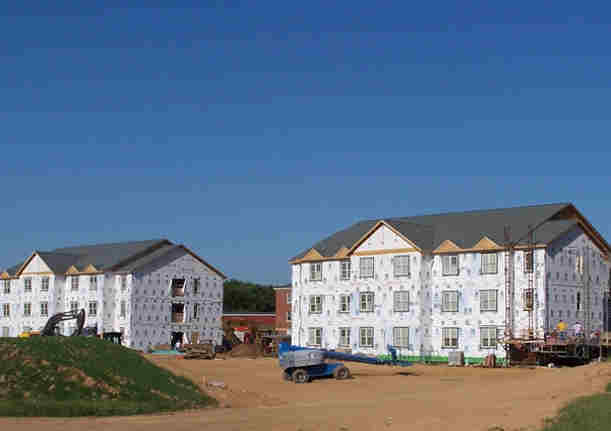Ambitious New York Modular Construction
Manhattan’s population is growing fast, and there’s simply not enough room to house everyone. Several modular buildings are underway in New York as city planners envision new ways to provide economical housing in the city.
One such project – a seven-story apartment building made entirely of modular units – is called “The Stack.” It opened in May 2014 and was selected as the Modular Building Institute’s August 2014 Modular Building of the Month in recognition for its cost-effective construction and speed of completion.

The Modular Process
The project was designed as a 37,000-square-foot mixed-use building with retail space on the ground floor and 28 apartments (consisting of 56 modules) above.
The Stack was constructed on a 50-foot-wide, 150-foot-deep site. As the foundation, basement, and first floor were being constructed in the traditional way, including most of the electrical and plumbing, the modules were being manufactured off-site. This process took about nine months to complete.
Completed modules were transported to the construction site with kitchen appliances, bathroom fixtures, light fixtures, cabinets and countertops pre-installed. The 56 units were then stacked atop the prepared structure in only 19 days with a crane and crew of eight. Plumbing and electrical connections were made between the modules, the elevator was installed, and the building façade was put on.
If you’re thinking that the modular units were identical and boring, think again. The Stack features five different floor plans from 1-bedroom to 3-bedroom units with private patios and terraces, and the building features a central courtyard.
Why Modular?
In the case of The Stack, the entire construction process was shortened by six to eight months, and the developer saved approximately 20% compared with the cost to build a stick-built structure.
In general, the major advantages of prefab modular construction include:
· Adaptable for any site or business use;
· Compatible with surrounding architecture;
· Single and multi-story designs suit any conceivable purpose;
· Budget-friendly; substantially less expensive than conventional buildings;
· Typically competed 40% faster than traditional construction;
· No factory delays due to bad weather;
· Off-site manufacture and pre-assembly minimize building site waste, noise, dust, debris, and vehicle carbon dioxide emissions;
· Sustainable; most new modular units are constructed of recycled steel, making them strong, fire-resistant and mold-resistant;
· Meet or exceed all state and local building codes.
Modular builders are able to work with sophisticated levels of design and construction that rival their conventional counterparts. Most manufacturers, such as Modular Genius which serves customers nationwide, have in-house architects or relationships with outside architectural firms to accommodate all sorts of design requirements. You will find innovative designs and aesthetics suitable for every industry, including education, healthcare, administration, housing, hospitality and retail.
New York, in fact, has several other large modular projects underway or recently completed, such as the Lehman College daycare center with 12,000-square-feet of classrooms stacked between two existing campus buildings, and the “My Micro NY” micro apartment building in Manhattan. Dozens more are waiting for approval.
One final, but important, advantage of modular construction is its ability to help you earn points toward LEED certification, reduce energy costs by 10% to 40%, and provide beneficial “green” incentives. This means that modular buildings in New York can reap enormous environment-saving benefits while meeting accelerated deadlines and solving rapidly evolving affordable housing needs.
